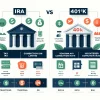
Tax season, which commences Feb. 12, presents unique challenges in 2021. From last year’s steep recession to a soaring stock market, enhanced unemployment benefits and economic stimulus payments, even ordinary tax filers face perplexing changes.
In a year marred by disease and economic disruption, Benjamin Franklin’s admonition that the only certainties in life were death and taxes was never more true.
With this in mind, we asked three tax experts to weigh in on important questions confronting taxpayers this year. Here’s what they had to say:
Do taxpayers owe income tax on the stimulus payments they received under the CARES Act?
No. The stimulus payments are not considered taxable income, said Jackie Perlman, principal tax research analyst at the Tax Institute at H&R Block. As such, they will neither reduce the size of a taxpayer’s refund nor increase their tax liability.
One thing to keep in mind, Perlman said, is that when a taxpayer files their 2020 tax returns, they could get an additional stimulus payment over and above the two advances if their circumstances changed during the year. A family may have missed out on the extra amount if they had a child in 2020, for example. In this case, when their 2020 tax return is filed, the family can claim up to an additional $1,100 ($500 and $600 per qualifying child) as a recovery rebate credit.
Furthermore, if a taxpayer’s stimulus payments were too high based on actual 2020 income — the stimulus payments were designed to phase out for individuals earning more than $75,000 a year and joint filers earning more than $150,000 a year — the IRS will not lower their refund nor add the difference to their balance due.
What if a taxpayer qualified for the stimulus payments but didn’t receive one or both of them?
If someone was entitled to stimulus payments based on their 2020 income but didn’t receive one or both of them, they can claim the missed payment as a credit on their 2020 tax return, explained Douglas Hord, principal at My Tax Guy in Houston LLC. The credit reduces the tax as if it were a payment and is refundable.
When it comes to the formalities of filing, taxpayers should have received an official notice from the IRS — Notice 1444 — along with their stimulus payments, said Candice Maceiras, Houston area manager for Jackson Hewitt. This form provides information about the amount of a taxpayer’s stimulus payment, how the payment was made and how to report any payment that wasn’t received. It’s important to keep this in your records, Maceiras said.
What’s the standard deduction for 2020?
The standard deduction increased slightly, Hord says. For single persons, it’s now $12,400, for a single person who’s head of household it’s $18,650 and for married individuals filing jointly it’s $24,800.
How did the deduction for charitable contributions change?
An especially notable change this year is that taxpayers don’t have to itemize to deduct charitable donations, Maceiras explained. Taxpayers can take an above-the-line deduction on their 2020 income taxes, even if they don’t itemize, for their charitable donations this year. Under the CARES Act, taxpayers can deduct up to $300 in charitable donations made to IRS approved organizations, even when they take the standard deduction.
Are there any changes to retirement-related savings/accounts that taxpayers should be aware of?
The maximum contributions to a variety of retirement accounts increased in 2020, Hord noted. An individual can contribute up to $19,500 to their 401(k), with the same limit applying to 457 and 403(b) plans. The cap on contributions to Simple IRAs increased by $500 to $13,500. For those with SEP IRAs, they can contribute the lesser of 25 percent of their compensation or $57,000.
There are no changes to traditional or Roth IRA limits, both of which remain at $6,000, plus an additional $1,000 for individuals age 50 and up.
Another change included in the CARES Act is that taxpayers can withdraw up to $100,000 to cover coronavirus-related expenses without incurring the typical 10 percent penalty, Maceiras said. The catch is that you must pay that back within three years to undo tax consequences from the distribution. To take advantage of this, a taxpayer must attach Form 8915-E to their return.
Distributions are considered coronavirus-related if the taxpayer or a family member had COVID-19 based on a CDC-approved test, or if they incurred financial consequences as a result of COVID-19 related conditions, such as if they weren’t able to work due to a lack of childcare or if they were furloughed or laid off.
When can taxpayers expect to receive refunds?
The IRS sends out most refunds within three weeks, but sometimes it can take longer if the return needs additional review, Perlman said. For example, 25 million taxpayers could have refunds delayed until the first week of March because of anti-fraud laws requiring the IRS to hold refunds that claim the earned income tax credit and the additional child tax credit.
Hord expected that the earliest any refunds will be processed and sent this year will be around Feb. 22. But that’s only if the return is complete, all data conforms to what the IRS has received and direct deposit information is provided. The IRS advises that all refunds should be made by direct deposit this year, Hord said, as the agency expects delays in processing paper checks.
If a business received a loan under the Paycheck Protection Program, and that loan was forgiven, does that count as income to the business?
Normally, a forgiven loan is taxable income, but under the CARES Act forgiven PPP loans are not taxable, Perlman explainded. As a result, money received from a forgiven PPP loan will not be included in a business’ gross income at the federal level, though the business will want to confirm that it isn’t taxable on its state return. (Texas will not tax any PPP loan proceeds since it does not impose income tax.)
If a PPP loan was used to cover qualified expenses, can those payments also be written off as business expenses?
Under the Consolidated Appropriations Act 2021, eligible business expenses paid with proceeds of forgiven PPP loans are deductible, Perlman said. Business expenses eligible for forgiveness include payroll, mortgage interest, rent, utilities, software, supplies and personal protective equipment, or PPE. The latter includes protective equipment itself, as well as the cost to comply with health and safety guidelines, operational expenses for payments on software and other items for human resources and accounting needs, and essential supplier costs to keep a business open, including perishable goods.
What is the Employee Retention Tax Credit and when does it apply?
The CARES Act introduced new employer tax credits for businesses that have continued to pay employees during the pandemic, Perlman said. The refundable tax credit, known as the Employee Retention Credit, equates to 50 percent of up to $10,000 in wages paid by an eligible employer whose business has been financially impacted by COVID-19, according to the IRS website. The maximum credit, in other words, is $5,000 per employee. The credit applies to qualified wages paid after March 12, 2020, and before Jan. 1, 2021.







